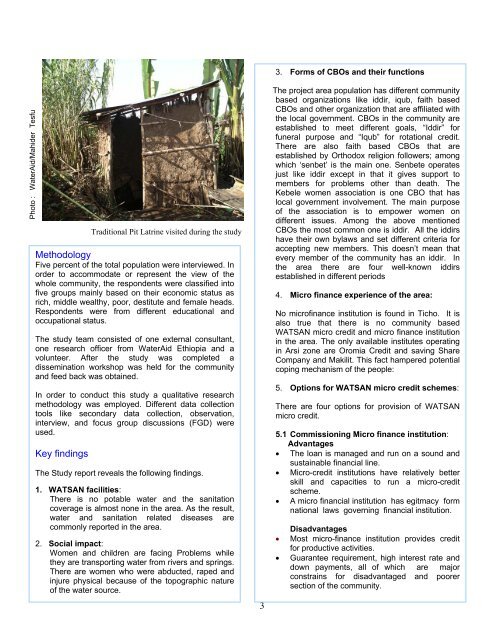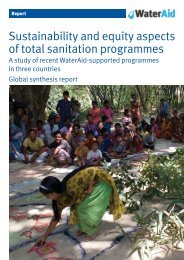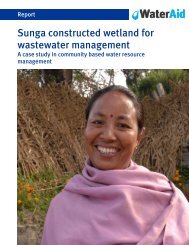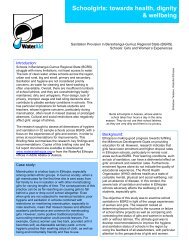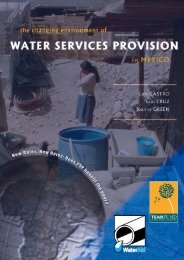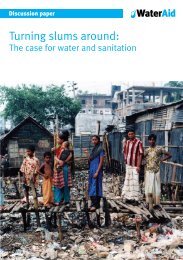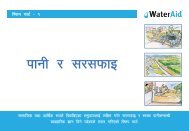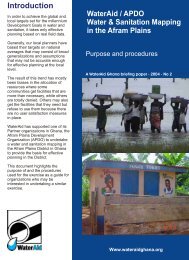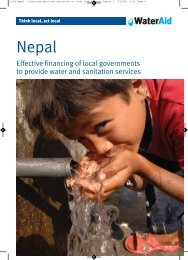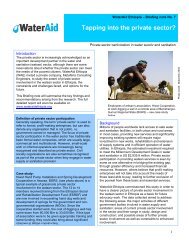Community-based organisations and options for WATSAN - WaterAid
Community-based organisations and options for WATSAN - WaterAid
Community-based organisations and options for WATSAN - WaterAid
Create successful ePaper yourself
Turn your PDF publications into a flip-book with our unique Google optimized e-Paper software.
Photo : <strong>WaterAid</strong>/Mahider Tesfu<br />
Methodology<br />
Five percent of the total population were interviewed. In<br />
order to accommodate or represent the view of the<br />
whole community, the respondents were classified into<br />
five groups mainly <strong>based</strong> on their economic status as<br />
rich, middle wealthy, poor, destitute <strong>and</strong> female heads.<br />
Respondents were from different educational <strong>and</strong><br />
occupational status.<br />
The study team consisted of one external consultant,<br />
one research officer from <strong>WaterAid</strong> Ethiopia <strong>and</strong> a<br />
volunteer. After the study was completed a<br />
dissemination workshop was held <strong>for</strong> the community<br />
<strong>and</strong> feed back was obtained.<br />
In order to conduct this study a qualitative research<br />
methodology was employed. Different data collection<br />
tools like secondary data collection, observation,<br />
interview, <strong>and</strong> focus group discussions (FGD) were<br />
used.<br />
Key findings<br />
Traditional Pit Latrine visited during the study<br />
The Study report reveals the following findings.<br />
1. <strong>WATSAN</strong> facilities:<br />
There is no potable water <strong>and</strong> the sanitation<br />
coverage is almost none in the area. As the result,<br />
water <strong>and</strong> sanitation related diseases are<br />
commonly reported in the area.<br />
2. Social impact:<br />
Women <strong>and</strong> children are facing Problems while<br />
they are transporting water from rivers <strong>and</strong> springs.<br />
There are women who were abducted, raped <strong>and</strong><br />
injure physical because of the topographic nature<br />
of the water source.<br />
3<br />
3. Forms of CBOs <strong>and</strong> their functions<br />
The project area population has different community<br />
<strong>based</strong> organizations like iddir, iqub, faith <strong>based</strong><br />
CBOs <strong>and</strong> other organization that are affiliated with<br />
the local government. CBOs in the community are<br />
established to meet different goals, “Iddir” <strong>for</strong><br />
funeral purpose <strong>and</strong> “Iqub” <strong>for</strong> rotational credit.<br />
There are also faith <strong>based</strong> CBOs that are<br />
established by Orthodox religion followers; among<br />
which ‘senbet’ is the main one. Senbete operates<br />
just like iddir except in that it gives support to<br />
members <strong>for</strong> problems other than death. The<br />
Kebele women association is one CBO that has<br />
local government involvement. The main purpose<br />
of the association is to empower women on<br />
different issues. Among the above mentioned<br />
CBOs the most common one is iddir. All the iddirs<br />
have their own bylaws <strong>and</strong> set different criteria <strong>for</strong><br />
accepting new members. This doesn’t mean that<br />
every member of the community has an iddir. In<br />
the area there are four well-known iddirs<br />
established in different periods<br />
4. Micro finance experience of the area:<br />
No microfinance institution is found in Ticho. It is<br />
also true that there is no community <strong>based</strong><br />
<strong>WATSAN</strong> micro credit <strong>and</strong> micro finance institution<br />
in the area. The only available institutes operating<br />
in Arsi zone are Oromia Credit <strong>and</strong> saving Share<br />
Company <strong>and</strong> Makilit. This fact hampered potential<br />
coping mechanism of the people:<br />
5. Options <strong>for</strong> <strong>WATSAN</strong> micro credit schemes:<br />
There are four <strong>options</strong> <strong>for</strong> provision of <strong>WATSAN</strong><br />
micro credit.<br />
5.1 Commissioning Micro finance institution:<br />
Advantages<br />
• The loan is managed <strong>and</strong> run on a sound <strong>and</strong><br />
sustainable financial line.<br />
• Micro-credit institutions have relatively better<br />
skill <strong>and</strong> capacities to run a micro-credit<br />
scheme.<br />
• A micro financial institution has egitmacy <strong>for</strong>m<br />
national laws governing financial institution.<br />
Disadvantages<br />
• Most micro-finance institution provides credit<br />
<strong>for</strong> productive activities.<br />
• Guarantee requirement, high interest rate <strong>and</strong><br />
down payments, all of which are major<br />
constrains <strong>for</strong> disadvantaged <strong>and</strong> poorer<br />
section of the community.


